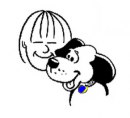A Solid Recall
When we demonstrate recall in class, we make it look really easy, we handle and command our demo dogs pretty much the same every time. It looks easy the same way as Elton John playing piano looks easy. But unlike Elton’s piano playing it actually is easy. Maybe the fact that it looks easy (and is easy!), leads people to think that means we don’t need to practice it. Walking is easy, but every baby – and adult who has to regain the ability to walk – needs to practice it.
Recall – Sticking With the Programme
Everybody knows recall is important. And I hope I manage to get it through to folk in the Big Brain Bit how important. It’s the lifesaving exercise. For most pet dogs, it’s the only exercise we teach which saves lives.
We want him to come straight away – not to have another second’s worth of sniffing while he considers the matter. We want him to come quickly – not to grab another sniff on the way back. We want to be able to catch him so we can get him away from any danger as quickly as possible.
Our voice command is really important. Verbal command should be very clear and as far as possible it should sound the same every time we use it. A higher tone of voice works better than a deep tone, deep tones of voice create avoidance behaviour. You might get your recall, but it’s not likely to be fast if you sound angry when you call him.
Whistles are great, but they’re not magic. They are just very clear. Downside? We still need a verbal, one day we’ll not have the whistle to hand. Another downside, there’s a risk somebody else on the field will have the same whistle!
Catch

Jenny with Henry. Drilling target/catch. I do have clicker in my hand, but I wouldn’t click, we’re too close to his ear.
Drilling, over and over, exactly the same each time.
At least once a day while he’s still in training and every so often throughout his life, keep him sharp.
Should take about a minute and a half, maybe a bit more.
So he’s really clear about what a recall feels like and so do you.
Some Dos and Don’ts
Don’t use the clicker to recall your dog unless you’re not going to use it to support the rest of your training. It might work initially, but it is a very poor command at a distance and if you use it to trigger (command) a recall, it won’t work properly to mark that successful recall (or other behaviour) after he’s done it.
Do encourage him when he’s on his way back, but don’t call him loads of times unless you really are desperate. Call him once then as he’s on his way back tell him how clever he is (now’s the time to squeak that toy!). “Paris come!” He starts to come. “Good boy, how clever you are, super boy…” etc.
Use the audios on your Web Course. Look for this image them.
And the really obvious don’ts, but I have to say it.
NEVER, not ever, tell him off when you get him back. Even if he’s kept you standing in the rain for half an hour. I see this all the time in the park, people eventually catch their under-trained dog then he gets a good talking too or even a smack for showing owner up in public. Next time dog is worse, he’s learned coming back is a really bad deal.
Saying that, you don’t have to give him half a chicken for a poor recall, just don’t punish him for it. Your fix is in what I’ve said above. So, if he’s given you a poor recall, you’re the one with the big brain, it’s your responsibility to get going and work the fixes.
In Summary
Stick with the programme!
PUBLIC VERSION. Public versions of student questions are summmarised, mostly for confidentiality reasons.


